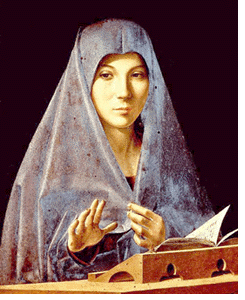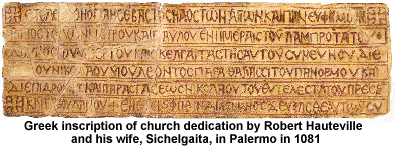...Best of Sicily presents... Best of Sicily Magazine. ... Dedicated to Sicilian art, culture, history, people, places and all things Sicilian. |
by Antonella Gallo | |||
Magazine Index Best of Sicily Arts & Culture Fashion Food & Wine History & Society About Us Travel Faqs Contact Map of Sicily
|
Outside the world's largest cities, it is usually presumed that smaller art galleries base their claim to fame on a few masterpieces. Palazzo Abatellis has its share of these, but the general collection may be a little overrated, at least to those of us familiar with art collections elsewhere. Most of the Abatellis collection is Late Medieval and Baroque. Here's what you can expect to see. Several gems of the art world are kept here. Antonello da Messina's Annunciation (shown here), painted in a mixed oil and egg tempera technique, is, even by Renaissance standards, a unique work, and perhaps the most important painting in Sicily. This alone is worth the price of admission. Like the Mona Lisa, it is a small painting on a wood panel. Three of da Messina's lesser works are also housed at Palazzo Abatellis. Francesco Laurana was an important sculptor of the same period, and two of his distinctive busts are displayed here. The head of Eleonora of Aragon is the better known, and perhaps the more beautiful. When I visited, it was displayed "in the open," without a protective glass case, and while the building's modern security system is efficient, one might question the wisdom in this. However, it does offer visitors a direct, close-up view of a magnificent work of art, affording the chance to actually walk around it and see it from just inches away. This is one of the more remarkable things about Sicily's museums (and something rarely seen in Paris, London or New York), where precious art is truly presented directly to the people to appreciate. It helps to make art part of life. Another important factor is the presence of Norman, Arab and Byzantine art and architecture in its original (and natural) context, such as churches, palaces and outdoor sculpture. Appreciating the works in their possession, the curators have placed the masterpieces of da Messina and Laurana each at the center of small chambers in the museum. On a Baroque note, an interesting piece is a painting by Anthony van Dyck (though this is not always on display). This is not his only work in Palermo, where the small church in Via Bambinai behind the apse of the San Domenico Basilica exhibits one of his larger paintings. The regional art galleries are a network of galleries and museums represented in various provinces of Sicily. That's why there's a "regional" gallery and museum in Siracusa and Catania as well as Palermo - each one housed in a historic building. Palermo's "modern" art museum in the Saint Ann convent (in Piazza Sant'Anna near Piazza dei Vespri and Palazzo Gangi) displays works created after 1800 The Arab and Norman periods are not overlooked, but don't expect to see too much actual art. In a corner gallery up a short flight of steps off the main courtyard is a chamber housing a number of columns and tablets bearing Arabic inscriptions, and, in Greek, the eleventh-century dedication of a Palermo church (shown here) by the Norman conqueror of Sicily Robert "Guiscard" Hauteville and his wife. In the general collection, several Byzantine icons are preserved, including the fragment of a beautiful mosaic of the Theotokos. A few pieces of fresco are preserved as well, and some painted wood panels from the Middle Ages. The remainder of the collection is dedicated to large paintings by Gagini
and other competent artists not Fortunately, this flawed impression is easily remedied by a visit to Palermo's medieval churches and palaces - the Zisa, Palatine Chapel, Martorana and others. The regional archeology museums of Palermo and Catania display a great number of classical works, such as the recently-discovered Imperial heads. Palazzo Abatellis should be considered, if at all, as complementing these other sites. In art, it's important to see the whole picture. The Steri Castle is in Piazza Marina nearby, down Via Quattro Aprile, where Lorenzo's "chocolate bar" at number 7 serves coffee, desserts and much more than chocolate. About the Author: Antonella Gallo, who teaches art in Rome, has written numerous articles on arts and artists for Best of Sicily. | ||
Top of Page |
 Built in the 1490s
in the Catalonian Gothic style, Palazzo Abatellis is an interesting structure
of sweeping arches, featuring an embattled tower and details such as a few rare Sicilian examples of medieval-style
Built in the 1490s
in the Catalonian Gothic style, Palazzo Abatellis is an interesting structure
of sweeping arches, featuring an embattled tower and details such as a few rare Sicilian examples of medieval-style
 very well known outside Sicily. Many pieces were salvaged from
churches and monasteries. While some are beautiful, others are simply overbearing
in style, composition and execution. This is the framework of the museum's
collection, and many visitors - even seasoned art historians - are likely
to find it rather redundant, even boring. If you visit Palazzo Abatellis but
no other Sicilian museum, you may be left with the impression of Sicilian art
as primarily a sixteenth-century development, as though virtually nothing
else existed before 1500.
very well known outside Sicily. Many pieces were salvaged from
churches and monasteries. While some are beautiful, others are simply overbearing
in style, composition and execution. This is the framework of the museum's
collection, and many visitors - even seasoned art historians - are likely
to find it rather redundant, even boring. If you visit Palazzo Abatellis but
no other Sicilian museum, you may be left with the impression of Sicilian art
as primarily a sixteenth-century development, as though virtually nothing
else existed before 1500.